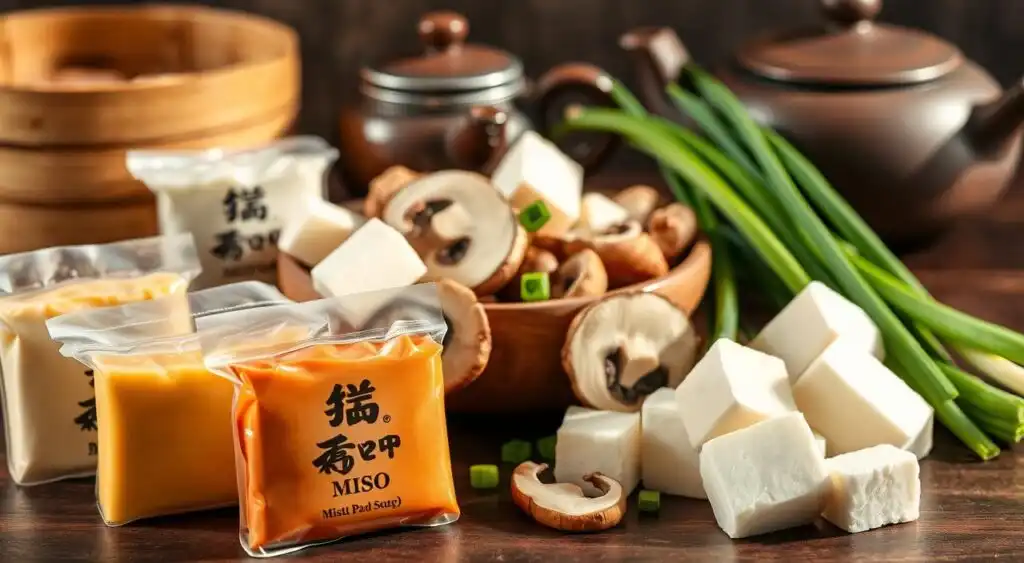There’s something deeply comforting about a warm bowl of homemade soup. It’s not just about the taste it’s the feeling of nourishment, the simplicity of the process, and the joy of creating something from scratch. If you’ve ever wondered how to make authentic miso soup at home, you’re in for a treat.
This traditional Japanese dish is surprisingly easy to prepare, even for beginners. With just a few key ingredients like miso paste, dashi, and tofu, you can craft a flavorful and nutritious meal in under 20 minutes. Unlike store-bought versions, homemade miso soup allows you to control the quality of ingredients, ensuring a richer taste and better health benefits.
Whether you’re looking for a quick lunch or a soothing dinner, this guide will walk you through every step. You’ll learn the importance of each component and discover tips to perfect your recipe. Let’s get started and bring a piece of Japanese tradition into your kitchen.
Table of Contents
Introduction to Authentic Miso Soup
Rooted in centuries of tradition, this dish offers more than just flavor it’s a cultural experience. Originating in Japan over 1,300 years ago, it has evolved from a luxury item to a staple in households worldwide. Its simplicity and nutritional value have made it a beloved part of daily meals.
Understanding the Origins and Benefits
This dish’s history is deeply tied to Japanese culture. Initially reserved for the elite, it became widely popular during the Edo period. The key to its unique flavor lies in the ingredient combination, particularly the fermented paste and dashi broth. These elements not only create a rich umami taste but also offer health benefits like probiotics and essential minerals.
“The art of making this dish is about balance balancing flavors, textures, and even heat,” says a traditional Japanese chef. Properly managing the heat ensures the delicate flavors are preserved, making every cup a comforting experience.
Why Homemade is Better Than Instant Versions
While instant versions are convenient, they often lack the depth of flavor and nutritional value of homemade recipes. When you prepare it from scratch, you control the quality of each ingredient, from the water to the paste. This ensures a richer taste and better health benefits.
Homemade versions also allow you to experiment with different recipe variations, tailoring the dish to your preferences. Plus, the process itself can be a rewarding experience, connecting you to a tradition that has stood the test of time.
Essential Ingredients for Your Miso Soup
Crafting an authentic bowl of this traditional dish starts with selecting the right ingredients. Each component plays a vital role in creating the perfect balance of flavors and textures. From the type of paste to the broth and garnishes, every choice matters.

Miso Paste Varieties and Their Flavors
The heart of this dish lies in the paste. White miso is mild and slightly sweet, making it ideal for beginners. Red varieties offer a deeper, more robust flavor, while mixed types provide a balanced profile. Choosing the right one depends on your taste preferences.
When you add miso to your recipe, remember to dissolve it properly to avoid clumps. This ensures a smooth, consistent texture. Fresh, high-quality paste enhances both flavor and health benefits.
Dashi, Kombu, and Other Key Components
The broth is another essential element. Traditional dashi is made with kombu (kelp) and bonito flakes, which infuse the liquid with umami richness. For a vegetarian option, skip the flakes and focus on kombu.
Other ingredients like silken tofu and seaweed add texture and depth. Silken tofu’s smoothness complements the broth, while rehydrated seaweed provides a subtle briny note. Don’t forget garnishes like green onion for a fresh finish.
By carefully selecting and balancing these components, you can create a dish that’s both authentic and tailored to your taste.
Preparing Your Dashi Broth
The foundation of any great Japanese dish lies in its broth, and dashi is no exception. This umami-rich stock is the backbone of countless recipes, offering depth and complexity. Whether you choose the traditional method or a quicker alternative, mastering dashi is essential.

Homemade Dashi Techniques
To make dashi from scratch, start with kombu (dried kelp) and bonito flakes. Soak the kombu in cold water for 30 minutes to extract its subtle flavors. Then, gently heat the water until it’s just below boiling. Remove the kombu before it boils to avoid bitterness.
Add the bonito flakes and let them steep for a few minutes. Strain the mixture through a fine-mesh bowl to ensure a clear, smooth stock. This method preserves the delicate flavors and creates a high-quality base for your dishes.
Shortcut Options: Dashi Packets and Powder
If time is short, dashi packets or powder are excellent alternatives. These products are pre-measured and easy to use. Simply dissolve them in hot water, and you’ll have a flavorful stock in minutes.
While homemade dashi offers a more nuanced flavor, these shortcuts are perfect for busy cooks. They still deliver the umami richness that makes Japanese cuisine so special.
Whether you go traditional or opt for a quicker method, the key is to set aside time to focus on the process. This ensures your broth has the depth and authenticity that elevate your cooking.
Step-by-Step Instructions to Make Miso Soup
Making this traditional dish at home is easier than you might think, and the results are worth every step. With a few simple techniques, you can create a flavorful and nutritious meal that’s perfect for any occasion.
Forming the Miso Slurry for Smooth Integration
Start by preparing your broth. Heat water in a pot and add kombu to infuse it with umami flavor. Once the broth is ready, remove the kombu and let it cool slightly.
Next, create a miso slurry. In a small bowl, mix a few tablespoons of miso paste with a small amount of warm broth. Stir until the paste dissolves completely. This step ensures the paste integrates smoothly into the soup without clumping.
Gently pour the slurry back into the pot. Avoid boiling the soup after adding the paste to preserve its delicate flavor and nutritional benefits.
Handling Tofu, Wakame, and Green Onions
Now, it’s time to add tofu. Use silken tofu for its soft texture, and cut it into small cubes. Add it to the pot carefully to avoid breaking it apart.
For the seaweed, rehydrate dried wakame in water for a few minutes. Once softened, drain and add it to the soup. This adds a subtle briny flavor and a pleasant texture.
Finally, chop green onions and sprinkle them on top just before serving. They add a fresh, crunchy finish that complements the dish perfectly.
- Always dissolve the paste in warm broth before adding it to the pot.
- Handle tofu gently to maintain its structure.
- Add wakame and green onions at the end for maximum flavor and texture.
By following these steps, you’ll create a dish that’s both authentic and tailored to your taste. Enjoy the process and savor the results!
Mastering the Perfect Miso Soup
Perfecting this traditional dish requires attention to detail and a balance of technique. From temperature control to ingredient adjustments, every step matters. Here’s how to elevate your recipe while keeping it authentic and practical for modern kitchens.
Achieving the Ideal Temperature and Timing
Temperature plays a crucial role in preserving the delicate flavors and nutritional benefits of your dish. Heat your broth to around 205°F before adding the paste. This ensures the probiotics remain intact while enhancing the umami taste.
After adding the paste, avoid boiling the mixture. Instead, let it simmer gently to maintain a final serving temperature of about 167°F. This approach keeps the flavors balanced and the texture smooth.
Timing is equally important. Add ingredients like kelp and tofu at the right moment to ensure they’re perfectly cooked. For example, rehydrate dried seaweed just before adding it to the pot for the best texture.
Balancing Traditional Flavor with Modern Shortcuts
While traditional methods offer depth, modern shortcuts can save time without sacrificing quality. For instance, using dashi powder instead of making broth from scratch still delivers rich flavor. Adjust the amount to suit your taste, typically one tablespoon per four cups of water.
If you prefer a bolder taste, try red miso. Its robust flavor pairs well with hearty ingredients like tofu and kelp. Use precise measurements, such as one tablespoon of paste per cup of broth, to achieve the perfect balance.
- Note the importance of turning off the heat before adding the paste to preserve its nutrients.
- Experiment with ingredient ratios to tailor the dish to your preferences.
- Combine traditional techniques with time-saving tools for a seamless cooking experience.
By mastering these advanced tips, you can create a dish that’s both authentic and convenient. Whether you’re a seasoned cook or a beginner, these instructions will help you achieve the perfect serving every time.
Troubleshooting and Pro Tips for Enhanced Flavor
Even the simplest recipes can have pitfalls, but with the right tips, you can avoid common mistakes. This section will guide you through troubleshooting and expert advice to elevate your dish.
Avoiding Common Mistakes in Preparation
One of the most frequent errors is overheating the broth. When you add miso paste, always turn off the heat first. Boiling can destroy the probiotics, reducing the health benefits.
Another mistake is improper incorporation of the paste. Use a small bowl to create a slurry by mixing the paste with a bit of warm broth. This ensures a smooth texture without clumps.
When prepping wakame, rehydrate it in water for a few minutes before adding it to the dish. This step enhances its flavor and texture, making it a perfect addition.
Tips for Storage, Reheating, and Preserving Probiotics
To maintain the rich flavor, store the broth and paste separately. This prevents the paste from breaking down and losing its nutritional value. Keep both in airtight containers in the fridge.
When reheating, avoid boiling. Gently warm the broth and add the paste afterward. This method preserves the probiotics and keeps the dish aromatic.
For a quick prep, consider making a larger batch of broth and storing it for later use. This saves time without compromising quality.
- Turn off the heat before adding the paste to preserve probiotics.
- Store broth and paste separately for better flavor retention.
- Rehydrate wakame properly for maximum texture and taste.
By following these tips, you’ll avoid common pitfalls and create a dish that’s both delicious and nutritious. Whether you’re a beginner or an experienced cook, these insights will enhance your miso soup recipe.
Conclusion
Bringing the essence of Japanese tradition into your kitchen is simpler than you think. With this guide, you’ve learned how to make miso soup that’s both authentic and tailored to your taste. From selecting high-quality ingredients to mastering the right temperature, each step ensures a flavorful and nutritious dish.
This soup recipe is not just about taste it’s about embracing a rich cultural heritage. The fermentation process adds probiotics, while ingredients like tofu and seaweed provide essential nutrients. Whether you follow traditional methods or use modern shortcuts, the result is a comforting meal that’s easy to prepare.
Feel free to experiment with flavors and techniques. Share your creation with loved ones and enjoy the process as much as the dish itself. With these tips, you’re ready to make miso a regular part of your culinary repertoire.
** Similar meals that may interest you:
How to Make Butternut Squash Soup
How to Make Taco Soup Fritos Recipe
1 thought on “How to Make Authentic Miso Soup at Home: A Step-by-Step”